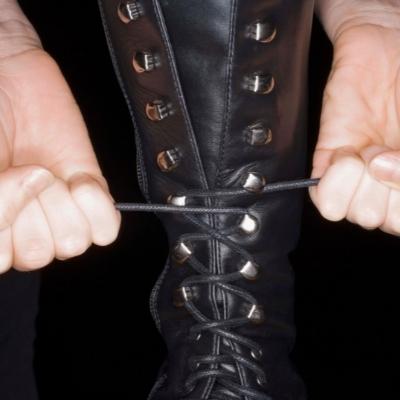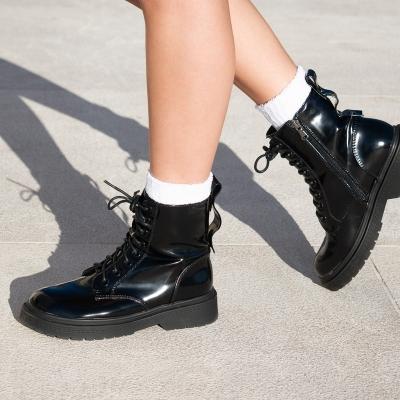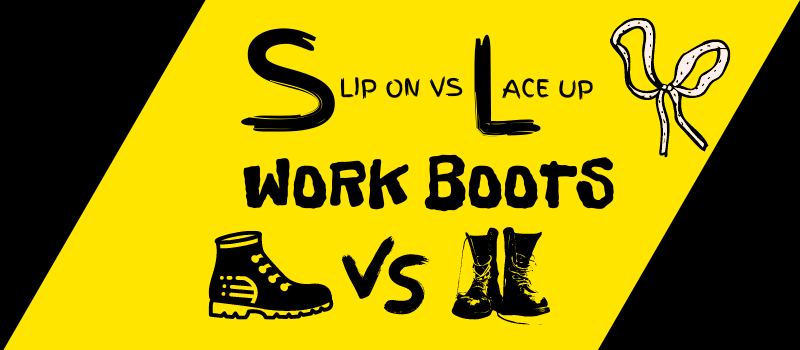Last Updated on August 9, 2023
Are you tired of constantly having to bend down and tie your work boots every morning? Maybe it’s time to consider switching to slip-on style work boots. But with so many options on the market, it can be tough to know which style is right for you. That’s where our article comes in! In this informative guide, we’ll compare slip on vs lace up work boots to help you decide which style is best for your needs.
Whether you’re a construction worker, warehouse employee, or simply in need of a more convenient and comfortable work boot, we’ve got you covered. We’ll take a look at the pros and cons of each style, as well as the different industries and job tasks they are best suited for. So if you’re tired of fumbling with laces every day and want to find the perfect work boots for your needs, keep reading!
Comparison Between Lace-up and Slip-on Boots

Slip-on boots vs. lace-up, the competition is quite a tough one. I’ll be frank with you both pull-on vs. lace-up work boots have their area of expertise and features in which they excel. So we can’t say that one is better than the other. Talking about differences, they have several differences of their own. However, at the same time, they have benefits as well. The laceless work boots are more manageable and convenient to wear and take off without any fuss.
In contrast, the lace-up boots provide good ankle support. You must be wondering which one is better for your job. To acquire insight into what these types of boots have in common and how they differ from each other, we need to observe the complete comparison.
Slip-On Work Boots
So what are slip-on work boots?
Slip-on work boots don’t have laces, so taking them on and off is easy. Usually, people in oil rigs and oil industries use these work boots. Workers need to pull on and take off their shoes quite often as required for that specific worksite.
The shoes are custom designed to fit precisely to their feet.
Some of the materials used in their construction include full-grain leather, nylon mesh, and synthetic leather material.
You can also check more information about the best slip-on work boots here.
Lace-up Work Boots
Lace-up boots consist of laces for adjustment, which provides a proper fit to your feet. These boots also provide ankle support, such as pull-on boots, most of the time. These boots have an excellent rugged appearance. Usually, lace-up work boots are suitable for people who work on challenging construction sites. Construction workers need more protection from the elements, so they wear boots that hug their feet tightly. Additionally, the boots are made of high-quality full-grain leather and rubber.
Slip-on vs Lace-up Work Boots: Understanding the Key Differences
Most people assume that these boots are used for professional and outdoor work purposes, but how do they differ? We are drawing a contrast between these two shoes, and distinction always requires differences. We will talk about some of the primary differences and similarities in their fit.
Fitting
I’m sure you’re wondering how these boots fit? Do lace-up boots feel tight? Are the pull-on boots too wide? How critical is fitting for slip on vs lace up work boots ?

For slip-on boots, it is pretty challenging to have a proper fit because they don’t have the convenient option of tying the laces. And the wrong pair may even lead to the cause of discomfort for your feet.
One of the things that I dislike about slip-on work boots is that some of these boots cannot provide safety. Moreover, they lose their shape with time. Some of the no lace boots are also non-resistant to punctures or compression.
On the other hand, if we talk about the lace-up boots fitting, it can be a lot of things simultaneously. The adjustable laces can tighten their grip on your feet and keep open space inside your boots so that they are more breathable.
One thing that differentiates lace-up boots from pull-on work boots is their durability. The lace-up boots are much better if you want to purchase boots for challenging conditions like concrete.
Work boots with lace-ups also provide better heel support, which can help prevent injuries while on the job. I like the lace-up category of work boots because even if your shoes start to lose their shape, you can still adjust them with the help of laces. Notable, isn’t it?
Safety And Protection
It is impossible to ignore safety when discussing pull-on vs lace-up work boots. Safety is a key factor. According to Harvard Health Publishing, approximately 18,000 older Americans die each year from injuries sustained during a fall. Pull-on boots vs. lace-up construction boots; provide all kinds of safety against hazards and injuries. The slip-on work boots don’t have laces, so this way, there are fewer chances of falling or tripping over them.
The boots are also oil and water-resistant, protecting them from slipping on construction work sites. A disadvantage I would like to mention here about no lace work boots is that they don’t have the luxury of laces; therefore, they are a little loose from their opening. Due to this, sometimes, the dirt particles may seep into your boots, which would make you feel uncomfortable and unclean.
In contrast, the lace-up work boots are much more protective than the former slip-on boots. Due to their lace fastening fit, they prevent dirt from getting inside the shoes. Moreover, they provide complete lace enclosed safety to your feet. Just make sure not to trip over your boot laces.
Ease of Wearing
Be it pull-on or lace-up work boots; you always look for the comfort and convenience of wearing them.

If we talk about the ease and comfort of wearing, I would say pull-on boots are much easier. You can easily slide your feet inside them and take them out quickly whenever you want, without any fuss. If we compare pull-on boots vs. lace-up oil field working sites, pull-on boots are a better choice. Rigger boots are usually an excellent choice for oil field work. Do you know why these are called Rigger boots? Well, I’ll tell you why. The workers earlier used them on the offshore oil rigs in the North sea. That is how they developed the name rigger boots. All rigger boots are essentially pull-on work boots. Presently several workers frequently wear them to all work sites.
However, we can’t seem to identify this comfort and ease in lace-up work boots as they require tying laces which is not a good time and energy-saving factor.
While you must bend to tie your laces with lace-up boots, you can simply slide your feet into pull-on boots while standing. So inconvenience factor, I would say pull-on boots are more accessible and convenient.
Supportive Ankle
Having supportive ankles in your work boots is necessary.

For example, if we talk about lace-up vs. pull-on motorcycle boots, they usually have ankle support. However, the lace-up motorcycle boots are much a better pick as they are more secure and safe while you’re riding a bike.
Pull-on work boots usually have little or no adequate ankle support.
Traction Levels
Falling, slipping, no proper grip on rocky or wet surfaces? Well, your boots must need adequate traction. Let me compare pull-on vs. lace-up hunting boots. If you ask me for a good hunting day outdoors, your feet need outstanding support to stay on the ground and walk through all the rough rocky places. Lace-up boots increase your boot traction levels. They don’t consist of laces, so they tend to prevent outdoor accidents in some cases. While on the other hand, if you’re wearing lace-up boots to a hunting site, you may have less traction and support. The reason for this is the lacing. You may only slip due to your loose laces.So beware!
If we talk about lace-up vs. pull-on cowboy boots, the latter is always better as cowboy boots style is best suited with a pull-on style.
Break In Period
Pull-on work boots require a longer break-in period than Lace-up work boots. Actually, you can adjust the fit of lace-up work boots to a certain degree, whereas pull-on work boots might require a break-in period, over which you have no control.
The break-in period is used to help the leather conform to the shape of your foot and the soles to stretch to a comfortable level. The break-in period varies depending on the type of work boot you are wearing, the manufacturer of the work boot, and the environment you are working in. The best way to determine the break-in period is to start working in your boots right after they arrive at your door.
Advantages and Disadvantages Slip-on and Lace-up Work Boots
We’ll sum up some of the strengths and weaknesses of pull-on vs. lace-up boots.
Advantages of Pull-on Work Boots

One of the biggest strengths of pull-on work boots is that they are pretty easy to wear. You can easily pull them on within a matter of a few seconds. What more do you want? Pull-on work boots also provide extra protection because of their excellent height.
Moreover, they don’t have the colossal fuss of tying laces which can also be a source of back pain while you bend down to tie them over and over again. Another good thing about them is that they prevent slipping on worksites because you won’t be tripping on your boot laces anymore!
One thing that I admire about pull-on boots is their breathability. They are incredibly open to ventilation and keep all the foul odor away from your shoes!
Advantages of Lace-up Boots
Lace-up boots have a more secure and tight fit. Due to this factor, they are pretty shock absorbing in nature.

There is also better ankle support as compared to pull-on boots. Outdoor construction workers commonly use these type of boots.
Disadvantages of Pull-on Boots
The boots usually have more wide opening space. Due to this, they are unable to provide proper safety and adequate warmth during the winter season. Moreover, you can’t do much when they start to lose their shape. You can’t tighten or fix them with the help of fastening laces or other material. Less ankle support is also a weakness of these boots.
Disadvantages of Lace-up Boots
You can never save time whenever you’re putting these boots on. They require lace closure which takes up some of your time and energy. You might also experience tripping over your shoes while running or walking at work.
I don’t admire these boots because they don’t have an excellent ventilation system. They are not breathable at all due to their fitted closure. This factor may also cause your feet to sweat and eventually produce a foul odor.
Comparison
| Feature | Slip-on Work Boots | Lace-up Work Boots |
|---|---|---|
| Comfort | Higher comfort level due to easy slip-on design. | May require breaking in period and tighter fit. |
| Support | Often have less support due to lack of lacing. | Good support due to adjustable lacing. |
| Convenience | Easy to slip on and off, ideal for quick tasks. | Time-consuming to lace and unlace, ideal for longer work sessions. |
| Safety | Can come off easily during work activities, posing a safety risk. | Good grip and stability due to lacing. |
Some Interesting Facts About a Pull on vs. Lace-up Boots
Whenever we talk about pull-on boots, a sudden flash runs across our minds, and our attention goes to cowboy boots. This pull-on boots design dates back to the industrial age when boots were handmade designs. The pull-on was also an influence on military boots and boots for riders. (Horseback riding was very common at the time).
Since the 19th century, several companies have been operational to manufacture pull-on boots, and it is still running!
Lace-up boots are the oldest and most common types of boots. The best kinds of lace-up boots are the derby and oxford. They were first seen in Ireland in 1500, during the Elizabethan era. They were a solution for men to keep feet dry on muddy surfaces. Several war soldiers also used the boots because of their ankle support.
FAQ:
I would say both are good in their comfort zones. However, if we talk about safety, lace-up boots are a better choice. In comparison, slip-on boots are better for ease of wear. Whichever you choose, always make sure it complements your style and comfort.
If you’re looking for ankle support, I suggest you go for lace-up boots. They provide you with a much more robust and firm fit and much more ankle support.
Whenever you slip your feet inside the boots, make sure they don’t hit the end of the shoes. There should be approximately an inch of space inside your work shoes.
There are many fine boots. But for pull-on work boots, I would recommend Caterpillar Revolver Steel toe pull-on boots. For lace-up boots, we would suggest you go for Thorogood American Heritage boots. Otherwise you can choose from any USA made pull on work boots.
Lace-up shoes can be better for your feet compared to slip-on shoes as they offer better support and fitting. The adjustable lacing allows for a customized fit to accommodate different foot shapes and sizes, providing better support to the foot and ankle. Lace-up shoes also provide better stability and grip, which can reduce the risk of injury during physical activity.
Final Thoughts
We hope you found our review quite informative and that you picked all the right things for yourself through this article. Moreover, you have a clearer idea about slip-on vs. lace-up work boots. Whichever style your work boots are, always find your perfect comfort and style in them. Please read some of our other articles to find interesting facts about work boots.
Mark Walter is an accomplished researcher and writer with a wealth of knowledge and experience in the world of work boots. His expertise in this field is unmatched, having worked in a variety of industries and work environments. Mark's writing is clear and concise, making him an ideal source of information for anyone looking to learn more about the importance of selecting the right work boots for the job.

















